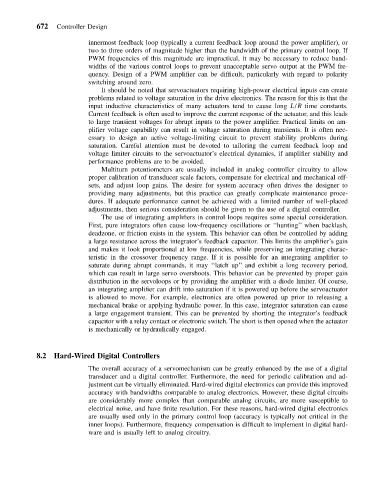Page 681 - Mechanical Engineers' Handbook (Volume 2)
P. 681
672 Controller Design
innermost feedback loop (typically a current feedback loop around the power amplifier), or
two to three orders of magnitude higher than the bandwidth of the primary control loop. If
PWM frequencies of this magnitude are impractical, it may be necessary to reduce band-
widths of the various control loops to prevent unacceptable servo output at the PWM fre-
quency. Design of a PWM amplifier can be difficult, particularly with regard to polarity
switching around zero.
It should be noted that servoactuators requiring high-power electrical inputs can create
problems related to voltage saturation in the drive electronics. The reason for this is that the
input inductive characteristics of many actuators tend to cause long L/R time constants.
Current feedback is often used to improve the current response of the actuator, and this leads
to large transient voltages for abrupt inputs to the power amplifier. Practical limits on am-
plifier voltage capability can result in voltage saturation during transients. It is often nec-
essary to design an active voltage-limiting circuit to prevent stability problems during
saturation. Careful attention must be devoted to tailoring the current feedback loop and
voltage limiter circuits to the servoactuator’s electrical dynamics, if amplifier stability and
performance problems are to be avoided.
Multiturn potentiometers are usually included in analog controller circuitry to allow
proper calibration of transducer scale factors, compensate for electrical and mechanical off-
sets, and adjust loop gains. The desire for system accuracy often drives the designer to
providing many adjustments, but this practice can greatly complicate maintenance proce-
dures. If adequate performance cannot be achieved with a limited number of well-placed
adjustments, then serious consideration should be given to the use of a digital controller.
The use of integrating amplifiers in control loops requires some special consideration.
First, pure integrators often cause low-frequency oscillations or ‘‘hunting’’ when backlash,
deadzone, or friction exists in the system. This behavior can often be controlled by adding
a large resistance across the integrator’s feedback capacitor. This limits the amplifier’s gain
and makes it look proportional at low frequencies, while preserving an integrating charac-
teristic in the crossover frequency range. If it is possible for an integrating amplifier to
saturate during abrupt commands, it may ‘‘latch up’’ and exhibit a long recovery period,
which can result in large servo overshoots. This behavior can be prevented by proper gain
distribution in the servoloops or by providing the amplifier with a diode limiter. Of course,
an integrating amplifier can drift into saturation if it is powered up before the servoactuator
is allowed to move. For example, electronics are often powered up prior to releasing a
mechanical brake or applying hydraulic power. In this case, integrator saturation can cause
a large engagement transient. This can be prevented by shorting the integrator’s feedback
capacitor with a relay contact or electronic switch. The short is then opened when the actuator
is mechanically or hydraulically engaged.
8.2 Hard-Wired Digital Controllers
The overall accuracy of a servomechanism can be greatly enhanced by the use of a digital
transducer and a digital controller. Furthermore, the need for periodic calibration and ad-
justment can be virtually eliminated. Hard-wired digital electronics can provide this improved
accuracy with bandwidths comparable to analog electronics. However, these digital circuits
are considerably more complex than comparable analog circuits, are more susceptible to
electrical noise, and have finite resolution. For these reasons, hard-wired digital electronics
are usually used only in the primary control loop (accuracy is typically not critical in the
inner loops). Furthermore, frequency compensation is difficult to implement in digital hard-
ware and is usually left to analog circuitry.

